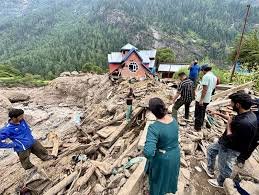Jammu, September 2, 2025 : The twin tragedies of Chositi in Kishtwar and Vaishno Devi in Reasi have reignited a debate over the safety and regulation of pilgrimages in Jammu and Kashmir. Experts and locals are calling for stricter monitoring, scientific planning, and ecological safeguards to prevent further loss of life.
Twin Disasters Raise Alarm
On August 14, a devastating flash flood struck Chositi village in Kishtwar during the Machail Mata Yatra, claiming at least 65 lives. Another 32 pilgrims remain missing and are feared dead. Barely two weeks later, on August 26, a landslide on the Vaishno Devi track in Reasi killed 34 pilgrims.
While smaller mishaps have been reported during pilgrimages in the past, such large-scale disasters occurring in quick succession are rare. The back-to-back tragedies have highlighted the extreme vulnerability of religious yatras in the Himalayan belt.
Climate and Development Stress
The fragile Himalayan ecosystem in Jammu is showing increasing signs of stress from both climate change and infrastructure expansion. Widening work on the Jammu–Srinagar National Highway has loosened soil in the Ramban sector, leading to frequent landslides. Throughout August, flash floods in Doda, Kishtwar, Reasi, and other districts claimed dozens of lives, underscoring the fragile state of the region.
Experts warn that glacier melt, cloudbursts, and erratic monsoon patterns are making pilgrimages riskier than ever.
Rising Footfalls, Rising Risks
The risks are further amplified by the rising number of pilgrims. The Vaishno Devi shrine alone attracts over one crore devotees annually, while yatras such as Budha Amarnath in Poonch and Sudh Mahadev and Pingla Mata in Udhampur also draw lakhs of visitors each year. These routes pass through landslide-prone and weather-sensitive terrain, where sudden downpours or flash floods can turn fatal.
Rapid development of roads, lodgings, and other facilities to cater to this influx has added to environmental stress, weakening natural safeguards and destabilizing slopes.
Call for Scientific Planning and Regulation
Experts, environmentalists, and civil society groups are urging authorities to adopt scientific planning and regulation of yatras. Suggested measures include:
-
Limiting the number of pilgrims in sensitive stretches.
-
Regular safety audits of pilgrimage routes.
-
Strict enforcement of environmental safeguards.
-
Mandatory adherence to Meteorological Department advisories during the monsoon.
Future infrastructure development, they argue, must be based on scientific assessments and environmental clearances, rather than blind expansion that ignores terrain and weather risks.
Faith vs. Safety: A Moral Imperative
The recent tragedies have underlined the urgent need to balance faith with safety. While yatras remain a deeply rooted cultural and religious tradition, experts say they must not come at the cost of human lives.
“Ensuring the safety and well-being of pilgrims through thoughtful planning, regulation, and monitoring is not just an administrative task—it is a moral obligation,” a senior official observed.



















